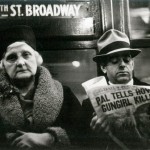Dir. by Michael Haneke
“The guard is down and the mask is off, even more than in lone bedrooms where there’s a mirror. People’s faces are in naked repose down in the subway.”
— Walker Evans“Television is a stream of underselected images, each of which cancels its predecessor. Each still photograph is a privileged moment, turned into a slim object that one can keep and look at again.”
— Susan Sontag
Twice during Code Unknown, director Michael Haneke cuts together montages of still photographs. The first is a series of grisly images from war-torn Kosovo; the second is a collection of portraits taken surreptitiously (if we are to believe the film’s narrative) on the Paris Metro. The second montage is actually the work of documentary photographer Luc Delahaye, but his obvious forebear is Walker Evans, whose hidden camera work on Depression-era New York subway trains resulted in the book, Many Are Called (1966).
In “America, Seen Through Photographs, Darkly,” Susan Sontag calls Evans an heir to Walt Whitman’s “euphoric” humanism. “To photograph is to confer importance,” she writes, and Evans’ photos, or so the argument goes, democratize their subjects by leveling the playing field — “leveling up,” Sontag notes. Viewed through his lens, the Victorian homes of Boston are exactly as beautiful, as ugly, and as important as the dusty cotton towns of south Alabama. Evans’ images are, in his own words, “literate, authoritative, transcendent.” Sontag continues:
The moral universe of the 1930s being no longer ours, these adjectives are barely credible today. Nobody demands that photography be literate. Nobody can imagine how it could be authoritative. Nobody understands how anything, least of all a photograph, could be transcendent.
I doubt I’ll be the only participant in today’s blog-a-thon to call upon Saint Susan. They’re too obvious a pairing, Sontag and Haneke — sharp intellects, determined moralists, and impossibly talented craftsmen, both. The question that’s nagging at me, though, is whether Haneke’s films, in general, and Code Unknown, specifically, achieve the egalitarian aims for which Sontag praises Evans. As opposed to the streams of self-canceling images that spray from television, Haneke’s films are, perhaps, as hyperselected as moving images can be — I admire his precise direction like I admire the prose of a great essayist — but to what ends, exactly?
Haneke’s use of Delahaye’s “L’Autre” photos is, like so much of the film, a highly self-conscious gesture. In this allusion to Sontagian (?) romanticism, he critiques by juxtaposition the kind of contemporary, sado-pornographic photojournalism typified by George’s Kosovo pictures. (George’s dry voice-over reading of a letter to Anne as the montage of dismembered bodies and grieving faces spools by is another nice — if heavy — touch.) By comparison, the black and white portraits of disinterested subway riders are more artful and ambiguous, and, therefore, one might argue, more essentially human. After seriously considering the term for several years now, I still don’t understand what “transcendent” means, precisely, but I know that the second photo montage and the shots of deaf students drumming are my favorite moments in Code Unknown, perhaps because they short-circuit, temporarily, my intellectual processes during a film that, at times, feels too much like a high-minded parable.
Haneke’s allusion to Evans’ literacy, authority, and transcendence is problematized, though, by the scene in which we watch George take his subway photos. When he sits down in front of an attractive young woman, their knees only inches apart, it feels like a predatory act, one nearly as taut and tense as Anne’s later confrontation with an aggressive teenager. Again, the scene is highly self-conscious. George’s camera is Haneke’s camera, and it’s also every other camera documenting and fragmenting our lives (and it’s a weapon and a phallus, to boot — quite a potent symbol, this camera).
“People’s faces are in naked repose down in the subway,” Evans tells us, but why should we believe him? I’m not sure that I do, and Haneke almost certainly doesn’t. Even the photo that appears on the cover of the most recent edition of Many Are Called (see above) betrays the Heisenberg-like effect of Evans’ camera on his subjects. That woman on the left, it seems to me, is — if not wholly aware that she is being photographed — at least suspicious of that man sitting across the aisle from her. Or, perhaps Sontag is right, and Haneke and I are simply enjoying, begrudgingly, the symptoms of our postmodern cynicism. Literate in the debates surrounding image culture, we strike the moral pose, asking tough questions, complicating assumptions, conscious all the while of the vast gulf that separates our bourgeois thumb-twiddling from power.
In Code Unknown, Haneke harkens toward the prelapsarian image — “the real face” — with the goal, I think, of infecting us with a similar nostalgia. Even the form of the film derives from that goal: each of the vignettes plays like one of Sontag’s “privileged moments . . . a slim object that one can keep and look at again.” Once afflicted by the longing for authority or for the proverbial “genuine article,” anything less — a traditional thriller like Anne’s new film, The Collector, for example — will be exposed as trivial or even morally harmful.
See also:
